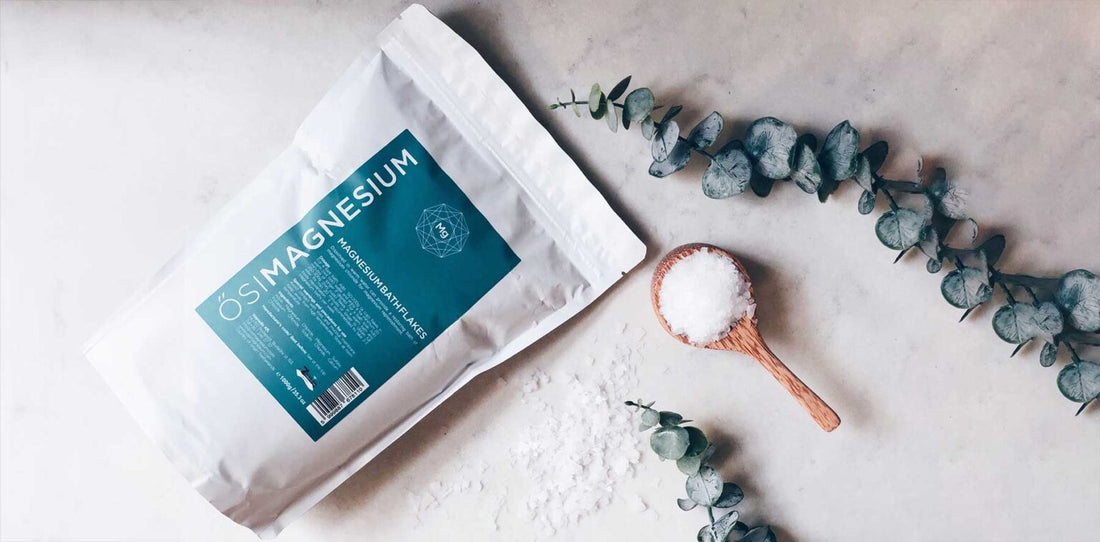
Magnesium 101: The Definitive Guide to Transdermal Magnesium
Share
Some have nicknamed magnesium the ‘master mineral’ because of its importance to so many physiological and metabolic processes in the body.
These include energy metabolism, making proteins, muscle and nerve function, blood glucose and blood pressure control. Magnesium is mainly stored in the bone, muscle, and soft tissue, absorbed through the small intestine and regulated by the kidneys.
What causes magnesium deficiency?
Recently more of us are becoming nutritionally deficient in magnesium because of modern farming and food preparation methods. Studies have shown that levels of various minerals and vitamins in our food have steadily declined since the 1940s, including:
- A loss of 53% potassium and 60% iron in spinach
- A loss of 75% calcium from broccoli
- An average loss of 24% magnesium from vegetables (with carrots losing 75%)[1]
This loss is due to several reasons: the use of industrialised chemicals on farmed land, soil management and crop rotation techniques.
Several studies have shown that on average people have a dietary intake of magnesium lower than the Recommended Daily Allowance (RDA) of 270 to 300 mg per day. Over 50% of the population may have ‘marginal magnesium deficiencies’. Although magnesium status will differ across subpopulations (young vs. old, sedentary vs. active).[2]
An imbalance in magnesium levels in the body (hypomagnesemia) might result in ‘unwanted neuromuscular, cardiac or nervous disorders.’ [3]
Other factors that can cause an increased loss of magnesium include stress of all kinds — emotional, environmental or physical (i.e. pain and injury, or intestinal disease).
Why oral supplementation isn’t always the ideal solution to deficiency
Until recently, most of us have relied on oral supplementation as the preferred route of topping up low levels of vitamins and minerals, but this is not always a reliable method. If stomach acid is insufficient, or there is poor bioavailability, this limits what can be absorbed.
What about oral magnesium? The form of magnesium salt makes a big difference to how far you can utilise it. For example, magnesium oxide has a high loading of elemental magnesium but poor bioavailability. Furthermore, too much oral magnesium can cause unwanted side effects like cramping and diarrhoea.
Transdermal magnesium on the other hand, offers a new paradigm in magnesium supplementation. It is a proven method that delivers active levels of magnesium in a fast, effective, and targeted form that bypasses the digestive system.
Transdermal magnesium is based on magnesium chloride, one of the most bioavailable forms; furthermore, OSI Magnesium uses magnesium chloride from the ancient Zechstein seabed. This is the purest source of magnesium chloride available, hidden deep in the earth’s crust.
Why you should take transdermal magnesium
When used regularly, one study demonstrated that transdermal magnesium restores cellular magnesium levels between 3 and 8 times faster than oral supplementation.[4]
In addition, the same study found that almost 80% of the same test subjects showed a clear indication of detoxification of heavy metals.
OSI Magnesium has a range of transdermal magnesium products so you can choose the best product for your needs:
Whether you apply transdermal magnesium as a lotion, a spray oil, a butter or simply soak in OSI Magnesium’s Muscle Relax Bath Flakes, you can expect to benefit from magnesium’s effects on your wellbeing, such as:
- Better, deeper sleep and resilience to emotional stress
- Soothes nerves and positively impacts mood
- Regulates hormones and assists immune function
- More relaxed muscles, tendons and connective tissue
- Positively affects energy levels
- Reduction in tiredness and fatigue
- Better sports performance and endurance
The other great news is that these products are easy to integrate into your lifestyle. You can apply them before bed, or after a bath or shower, and they’re a great way to soothe the mind and body in preparation for a good night’s sleep. CBD aids the body’s own production of cannabinoids, which play a role in sleep, pain and mood. Melatonin is known as the sleep hormone which plays a key role in regulating the sleep/wake cycle.
Finally, OptiMSM is a purified sulphur compound that is a major building block of joint cartilage. These compounds provide important additional benefits that work in partnership with magnesium to soothe, protect and rejuvenate the body.
References
[1] McCance RA, Widdowson EM. The Mineral Depletion Of Foods Available To Us As a Nation (1940–2002) – A Review of the 6th Edition of McCance and Widdowson. Available from: http://www.mineralresourcesint.co.uk/pdf/Mineral_Depletion_of_Foods_1940_2002.pdf
[2] Blancquaert L, Vervaet C, Derave W. Predicting and testing bioavailability of magnesium supplements. Nutrients. 2019 Jul; 11(7): 1663. doi: 10.3390/nu11071663
[3] Ibid.
[4] K Watkins, PD Josling. A pilot study to determine the impact of transdermal magnesium treatment on serum levels and whole body CaMg ratios. European Journal for Nutraceutical Research. 2010. www.phytomedcentral.org.
